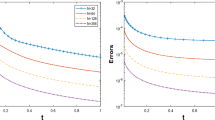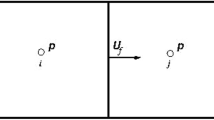Abstract
A novel and simple numerical method for stiff convection-dominated problems is studied in presence of boundary or interior layers. A version of the spectral Chevyshev-collocation method enriched with the so-called corrector functions is investigated. The corrector functions here are designed to capture the stiffness of the layers (see the Appendix), and the proposed method does not rely on the adaptive grid points. The extensive numerical results demonstrate that the enriched spectral methods are very accurate with low computational cost.












Similar content being viewed by others
References
Alexander, N.B., Hughes, T.J.R.: Streamline upwind/Petrov-Galerkin formulations for convection dominated flows with particular emphasis on the incompressible Navier–Stokes equations. Comput. Methods Appl. Mech. Eng. 32(1–3):199–259 (1982). FENOMECH ’81, Part I (Stuttgart, 1981)
Berger, A., De Han, H., Kellogg, B.: A priori estimates and analysis of a numerical method for a turning point problem. Math. Comput. 42(166), 465–492 (1984)
Brezzi, F., Russo, A.: Choosing bubbles for advection–diffusion problems. Math. Models Methods Appl. Sci. 4, 571587 (1994)
Canuto, C., Hussaini, M.Y., Quarteroni, A., Zang, T.A.: Spectral Methods in Fluid Dynamics. Springer Series in Computational Physics. Springer, New York (1988)
Chandler-Wilde, S.N., Graham, I.G., Langdon, S., Spence, E.A.: Numerical-asymptotic boundary integral methods in high-frequency acoustic scattering. Acta Numer. 21, 89–305 (2012)
DeSanti, A.J.: Nonmonotone interior layer theory for some singularly perturbed quasilinear boundary value problems with turning points. SIAM J. Math. Anal. 18(2), 321–331 (1987)
DeSanti, A.J.: Perturbed quasilinear Dirichlet problems with isolated turning points. Commun. Partial Differ. Equ. 12(2), 223–242 (1987)
de Groen, P.P.N., Hemker, P.W.: Error bounds for exponentially fitted Galerkin methods to stiff boundary value problems. In: Numerical and Asymptotical Methods for Singular Perturbation Problems, pp. 217–249. Academic Press, New York (1979)
De Han, H., Huang, Z.: Tailored finite point method for steady-state reaction–diffusion equations. Commun. Math. Sci. 8(4), 887–899 (2013)
De Han, H., Huang, Z.: Tailored finite point method based on exponential bases for convection–diffusion–reaction equation. Math. Comput. 82(281), 213–226 (2010)
De Han, H., Kellogg, B.: The use of enriched subspaces for singular perturbation problems. In: Proceedings of the China-France Symposium on Finite Element Methods (Beijing, 1982), pp. 293–305. Sci. Press Beijing, Beijing (1983)
De Han, H., Huang, Z.: The tailored finite point method. Comput. Methods Appl. Math. 14(3), 321–345 (2014)
de Ruijter, W.P.M.: On the Asymptotic Analysis of Large-Scale Ocean Circulation, volume 120 of Mathematical Centre Tracts. Mathematisch Centrum, Amsterdam (1980)
Eisen, H., Heinrichs, W.: A new method of stabilization for singular perturbation problems with spectral methods. SIAM J. Numer. Anal. 29(1), 107–122 (1992)
Gie, G.-M., Jung, C.-Y., Temam, R.: Recent progresses in boundary layer theory. Discrete Contin. Dyn. Syst. 36(5), 2521–2583 (2016)
Graciaa, J.L., O’Riordan, E.: Numerical approximation of solution derivatives in the case of singularly perturbed time dependent reaction-diffusion problems. J. Comput. Appl. Math. 273(1), 13–24 (2015)
Gottlieb, D., Orszag, S.A.: Numerical Analysis of Spectral Methods: Theory and Applications. Society for Industrial and Applied Mathematics, Philadelphia, PA (1977). CBMS-NSF Regional Conference Series in Applied Mathematics, No. 26
Guo, W., Stynes, M.: Pointwise error estimates for a streamline diffusion method on a Shishkin mesh for a convection–diffusion problem. IMA J. Numer. Anal. 17(1), 29–59 (1997)
Hong, Y., Jung, C.-Y., Temam, R.: On the numerical approximations of stiff convection–diffusion equations in a circle. Numer. Math. 127(2), 291–313 (2014)
Hong, Y.: Numerical approximation of the singularly perturbed heat equation in a circle. J. Sci. Comput. 62(1), 1–24 (2015)
Il’in, A.M.: A difference scheme for a differential equation with a small parameter affecting the highest derivative (in Russian). Mat. Zametki. 6, 237–248 (1969)
John, V., Knobloch, P.: On spurious oscillations at layers diminishing (SOLD) methods for convection–diffusion equations. I. A review. Comput. Methods Appl. Mech. Eng. 196(17–20), 2197–2215 (2007)
John, V., Knobloch, P., Savescu, S.B.: A posteriori optimization of parameters in stabilized methods for convection–diffusion problems—Part I. Comput. Methods Appl. Mech. Eng. 200(41–44), 2916–2929 (2011)
Jung, C.-Y., Nguyen, T.B.: Semi-analytical numerical methods for convection-dominated problems with turning points. Int. J. Numer. Anal. Model. 10(2), 314–332 (2013)
Jung, C.-Y., Temam, R.: Asymptotic analysis for singularly perturbed convection–diffusion equations with a turning point. J. Math. Phys. 48(6), 065301 (2007)
Jung, C.-Y., Temam, R.: Finite volume approximation of one-dimensional stiff convection–diffusion equations. J. Sci. Comput. 41(3), 384–410 (2009)
Jung, C.-Y., Temam, R.: Finite volume approximation of two-dimensional stiff problems. Int. J. Numer. Anal. Model. 7(3), 462–476 (2010)
Jung, C.-Y., Temam, R.: Singularly perturbed problems with a turning point: the non-compatible case. Anal. Appl. (Singap.) 12(3), 293–321 (2014)
Jung, J.-H.: A note on the spectral collocation approach of some differential equations with singular source terms. J. Sci. Comput. 39, 49–66 (2009)
Kieri, E.: Accelerated convergence for Schrödinger equations with non-smooth potentials. BIT Numer. Math. 54, 729–748 (2014)
Kellogg, B., Linss, T., Stynes, M.: A finite difference method on layer-adapted meshes for an elliptic reaction–diffusion system in two dimensions. Math. Comput. 77, 2085–2096 (2008)
Kellogg, R.B., Xenophontos, C.: An enriched subspace finite element method for convection–diffusion problems. Int. J. Numer. Anal. Model. 7(3), 477–490 (2010)
Li, Z.-C., Hu, H.-Y., Hsu, C.-H., Wang, S.: Particular solutions of singularly perturbed partial differential equations with constant coefficients in rectangular domains. I. Convergence analysis. J. Comput. Appl. Math. 166, 181–208 (2004)
Lynch, R.E., Rice, J.R.: A high order difference method for differential equations. Math. Comput. 34, 333–372 (1980)
Liu, W.B., Shen, J.: A new efficient spectral Galerkin method for singular perturbation problems. J. Sci. Comput. 11(4), 411–437 (1996)
Liu, W., Tang, T.: Error analysis for a Galerkin-spectral method with coordinate transformation for solving singularly perturbed problems. Appl. Numer. Math. 38(3), 315–345 (2001)
Miller, J.J.H., O’Riordan, E., Shishkin, G.I.: Fitted Numerical Methods for Singular Perturbation Problems. World Scientific Publishing Co., Inc., River Edge (1996)
Roos, H.-G.: Ten ways to generate the Il’in and related schemes. J. Comput. Appl. Math. 53, 43–59 (1994)
Roos, H.-G., Stynes, M., Tobiska, L.: Robust numerical methods for singularly perturbed differential equations, volume 24 of Springer Series in Computational Mathematics, 2nd edn. Springer, Berlin (2008). Convection–diffusion–reaction and flow problems
Simonnet, E., Dijkstra, H.A.: Spontaneous generation of low-frequency modes of variability in the wind-driven ocean circulation. J. Phys. Oceanogr. 32, 1747–1762 (2002)
Smith, D.R.: Singular-Perturbation Theory. Cambridge University Press, Cambridge (1985). An introduction with applications
Shen, J., Tang, T., Wang, L.-L.: Spectral Methods, Volume 41 of Springer Series in Computational Mathematics. Springer, Heidelberg (2011). Algorithms, analysis and applications
Shen, J., Wang, Y.: Müntz–Galerkin methods and applications to mixed Dirichlet–Neumann boundary value problems. SIAM J. Sci. Comput. 38(4), A2357 (2016)
Shih, S.-D., Kellogg, R.B.: Asymptotic analysis of a singular perturbation problem. SIAM J. Math. Anal. 18(5), 1467–1511 (1987)
Trefethen, L.N.: Spectral Methods in MATLAB, Volume 10 of Software, Environments, and Tools. Society for Industrial and Applied Mathematics (SIAM), Philadelphia (2000)
Tang, T., Trummer, M.R.: Boundary layer resolving pseudospectral methods for singular perturbation problems. SIAM J. Sci. Comput. 17(2), 430–438 (1996)
Tee, T.W., Trefethen, L.N.: A rational spectral collocation method with adaptively transformed Chebyshev grid points. SIAM J. Sci. Comput. 28(5), 1798–1811 (2006). (electronic)
Wang, Y., Chen, S., Wu, X.: A rational spectral collocation method for solving a class of parameterized singular perturbation problems. J. Comput. Appl. Math. 233(10), 2652–2660 (2010)
Zrahia, U., Orszag, S.A., Israeli, M.: Hybrid spectral element/asymptotic method for boundary layers problems. J. Comput. Phys. 138(2), 858–880 (1997)
Acknowledgements
The authors would like to thank the anonymous reviewers for their valuable comments and suggestions to improve the quality of the paper. After this paper was completed, we learned during an AMS Sectional meeting in Bloomington, Indiana, of the work of [43]. The authors resolved the singularities of the mixed Dirichlet–Neumann boundary value problems using a version of enriched spectral methods. However, the way of enrichment is not similar since different types of singularities are considered here. Chang-Yeol Jung was supported by the National Research Foundation of Korea grant funded by the Ministry of Education (2015R1D1A1A01059837).
Author information
Authors and Affiliations
Corresponding author
Appendix A: Elements of the Singular Perturbation Analysis
Appendix A: Elements of the Singular Perturbation Analysis
To treat the boundary and interior layers in a numerical method, we devise a corrector function to capture the sharpness of the layers. The behaviours of the layers much depend on the regularity of the limit solutions \(u^0\). More precisely, the discrepancies of the limit solutions \(u^0\) at the boundaries or at the interior point respectively produce the boundary and interior layers. To capture their sharpness, zooming near the layers with certain stretched variables we identify leading order differential operators which determine a corrector function. For more details on the singular perturbation analysis, see e.g. [6, 7, 25, 28, 41, 44].
1.1 Example for the Boundary Layer
In the following convection–diffusion equations with constant coefficients
the formal limit problem, i.e., when \(\varepsilon =0\), is
A boundary condition is assigned at the inflow \(x=1\). Observing that \(u^\varepsilon - u^0 \ne 0\) at \(x=-1\) and 0 at \(x=1\), we find that the discrepancy at the outflow \(x=-1\) leads to a sharp transition there. Introducing the stretching variable \(\bar{x}\) with \(x = \varepsilon \bar{x} - 1\), we identify the leading differential operators
The solution of (A.3) can be written explicitly,
and we expect \(u^\varepsilon \approx u^0 + \theta \). The rigorous analysis like a convergence analysis can be found in the references introduced in this “Appendix”. The function \(e^{-\frac{x+1}{\varepsilon }}\) represents the stiffness part of the boundary layer and it is defined as a corrector.
1.2 Example for the Interior Layer
For convection–diffusion equations which contain a turning point, we consider
where
and \(b'(x)> 0\). The interior layer arises at a turning point \(x=0\) where the sign of b(x) changes and the characteristics collide.
For the formal limit problem, we set \(\varepsilon =0\) in the above equation. Since \(b(0)=0\), \(\partial _x u^0\) may not be defined at \(x=0\) and we thus consider the left and right parts (\(u^0_l,u^0_r\), respectively) of \(u^0\) from \(x=0\),
The inflow boundary conditions are then supplemented,
The discrepancy at \(x=0\) between \(u^0_l\) and \(u^0_r\) produce an interior layer. If \(f(0) = 0\), the discrepancy is finite and thus the correctors introduced below can well capture the sharpness of interior layers. However, if \(f(0) \ne 0\), the limit problem
has an inconsistency at \(x=0\) since \(b(0) = 0\). This implies that \(\partial _x u^0\) blows up near \(x=0\) where the interior layers cannot be captured by corrector functions. To remedy this difficulty, one can lift \(u^\varepsilon \) so that the given data can be compatible (see (2.33)). For the singular perturbation analysis of the non-compatible case, see e.g. [28].
Using \(\bar{x} = x/\sqrt{\varepsilon }\) and \(b(x) = b'(0)x + \frac{1}{2}b^{''}(\xi )x^2 = b^{'}(0)\bar{x}\sqrt{\varepsilon } + \mathcal {O}(\varepsilon )\), some \(\xi \) with \(|\xi |\le |x|\), we substitute into (A.5) with \(f=0\) and obtain the leading differential operators,
supplemented with the boundary conditions,
The constants are accurately approximated by the standard spectral methods. A particular solution of (A.10) can be written explicitly,
which serves as a corrector.
Rights and permissions
About this article
Cite this article
Hong, Y., Jung, CY. Enriched Spectral Method for Stiff Convection-Dominated Equations. J Sci Comput 74, 1325–1346 (2018). https://doi.org/10.1007/s10915-017-0494-8
Received:
Revised:
Accepted:
Published:
Issue Date:
DOI: https://doi.org/10.1007/s10915-017-0494-8




